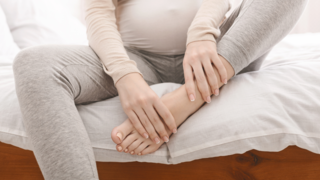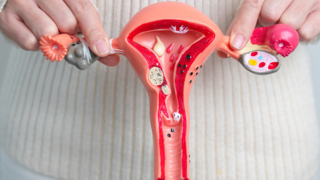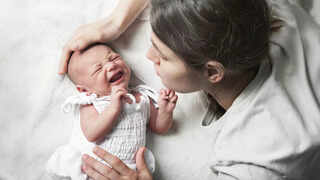In this article:
A diaphragmatic hernia arises during foetal development and alters the foetus's body build. Its abdominal organs, including the stomach, intestines, liver, gallbladder, pancreas, and spleen, may move upward into the chest cavity while it is still growing. When this occurs, the additional organs in the foetus's chest might squeeze the lungs, preventing them from developing appropriately.
What Causes A Congenital Diaphragmatic Hernia?
Congenital diaphragmatic hernia is a birth abnormality. The specific reason is uncertain, although it might be connected to:- Genetics
- Pregnancy might expose you to harmful environmental conditions
- Foetal malnutrition
Symptoms Of A Congenital Diaphragmatic Hernia(CDH)?
Babies born with CDH may have:- Abnormal breathing
- Rapid heart rate
- Cyanosis is blue discolouration caused by a lack of oxygen
- Weak breathing noises (typically from one side)
- Bowel noises in the chest
- Concave abdomen and barrel chest
- Abdominal discomfort
- Constipation caused by bowel blockage
What Are The Possible Complications Of CDH?
Most children born with congenital diaphragmatic hernia have tiny, undeveloped lungs (pulmonary hypoplasia). This might lead to a variety of problems, such as:Hypoxaemia (low blood oxygen levels) impairs the function of many organs, particularly the brain and heart. If it is severe or chronic, it may have long-term consequences.
Pulmonary hypertension refers to excessive blood pressure in the lungs' arteries. This disease stresses the right ventricle of the heart, potentially leading to heart failure.
Lung infections: Underdeveloped lungs are more susceptible to infections like pneumonia. This may be a lifetime health issue, even after the hernia has been corrected.
Infants with CDH are also susceptible to:
- Feeding issues: This might be due to digestive organ compression and gastro-oesophageal reflux symptoms, or simply challenging delivery conditions necessitating extensive medical intervention. Babies may need long-term tube feeding due to "failure to thrive" and growth issues. Some patients may need surgery to address GERD (Gastroesophageal reflux disease).
- Developmental delays: Some newborns may have developmental delays as a result of dietary and oxygen shortages. They may need physical, speech, or occupational treatment over time.
- Sensorineural hearing loss: Approximately 25% of newborns with CDH have progressive hearing loss. It's unknown if this is a side effect of the disease, the therapies (such as high-frequency mechanical breathing and drugs), or both.
How Is A Congenital Diaphragmatic Hernia Diagnosed?
Congenital diaphragmatic hernias are detected during normal prenatal ultrasounds. It will also show up in an amniocentesis, a prenatal test used to identify genetic diseases during the second trimester. Following the finding, your healthcare practitioner will do a foetal MRI (Magnetic Resonance Imaging) to see the hernia better. They will perform a foetal echocardiography to see if the heart is affected.Sometimes CDH is found after the baby is delivered. Your delivery team may see indicators of respiratory distress or structural abnormalities, such as an asymmetrical chest or a barrel chest with a tiny or concave belly. A chest X-ray and an echocardiography are performed on the baby and the team requests a blood sample to assess your baby's blood oxygen levels and search for any genetic abnormalities.
Rarely, kids born with CDH exhibit no visible symptoms. If the hernia is minor and does not produce any noticeable symptoms, it may not be identified until later in childhood or even adulthood.
How Is A Congenital Diaphragmatic Hernia Treated?
Ultimately, your kid will need surgery to fix the hernia. However, they will need more urgent treatments to prevent organ damage caused by the illness.Prenatal Treatment
Medical treatment for congenital diaphragmatic hernia starts soon after it is detected.- Surveillance: Doctors will check for congenital disorders in other organs to check for the severity of the hernia. They will also look for indicators of preterm labour and determine whether to induce labour early for the benefit of the foetus. You must have access to a hospital with a specialised team of physicians who treat CDH.
- Fetoscopy: In rare situations, your healthcare provider may be able to assist your foetus before delivery. Fetoscopic tracheal occlusion (FETO) is a surgical treatment that improves the size and function of the foetus's lungs while it is still developing. Fetoscopy is a minimally invasive operation that employs a tiny illuminated camera known as a fetoscope to observe the foetus via small incisions in your skin and uterus.
Neonatal treatment
Babies born with CDH often need urgent intensive care from a specialised team.- Oxygen Support: Most babies with pulmonary hypoplasia (underdeveloped lungs) need oxygen assistance early. For others, this entails a breathing tube connected to a mechanical ventilator. Others may need more aggressive life support, known as extracorporeal membrane oxygenation (ECMO).
- Surgery: A paediatric anaesthesiologist will provide anaesthesia to your infant during surgery. A paediatric surgeon will operate on your infant to realign their organs and fix the diaphragm deformity.
Recovery
As your baby recovers from surgery, they will gradually be transitioned off oxygen support. They will need to be fed via a tube until their breathing tube is removed. After that, speech and lactation professionals can help you and your baby start mouth feeding. Some newborns need longer to shift from oxygen assistance to tube feeding. Your healthcare team will support you for as long as required.What Is The Difference Between A Diaphragmatic And A Hiatal Hernia?
A hiatal hernia is a form of diaphragmatic hernia that is not congenital, which means, it does not occur at birth. It occurs later in your life. It's quite prevalent and far less dangerous than CDH. A hiatal hernia develops via an existing gap in your diaphragm, where your oesophagus crosses from your chest to your belly. It affects both children and adults.A hiatal hernia develops when abdominal strain from coughing or heavy lifting causes the diaphragm to weaken. This weakening impairs the diaphragm's existing aperture through which your oesophagus flows. It permits the lower half of your oesophagus and the upper section of your stomach to slide partially through the aperture. It produces minor symptoms and may not need to be corrected.
If your baby is born with CDH, they will need urgent critical care and a lengthy hospital stay. They may need ongoing follow-up treatment after that. You and your baby will be supported by a diverse team of healthcare professionals, including paediatricians, surgeons, nutritional and developmental experts, and therapists. Your team will be there for you at every step, from the time you're diagnosed (typically during pregnancy) until your child's early years.
FAQs on What Is Congenital Diaphragmatic Hernia? Diagnosis, Risks, and Management
- How dangerous is a congenital diaphragmatic hernia?
Babies born with this syndrome often have small, undeveloped lungs and weak blood arteries. This may lead to low blood oxygen levels and breathing problems during delivery. They will also have excessive blood pressure in their lungs, putting strain on their heart. These newborns will need critical treatment upon delivery to stabilise their condition. They may need supported care throughout their lives. - How common is a congenital diaphragmatic hernia?
Congenital diaphragmatic hernia affects around one in every 2,500 to 3,500 live births. About half of these are isolated anomalies that do not exist under any other circumstances. The other half are associated with other genetic abnormalities, such as congenital heart problems and Down syndrome.






